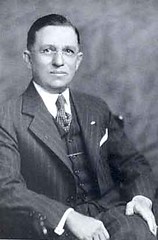
PREV ARTICLE
NEXT ARTICLE
FULL ISSUE
PREV FULL ISSUE
CHIPPING AWAY AT B. MAX MEHL'S COST CODEHarry Cabluck of Austin, Texas submitted this attempt to crack the puzzle of B. Max Mehl's cost code described by Ron Guth.
As good a guess as anything else: DEZPOTICUS. It cannot be YOUDESPOT, too many O's. Nor YOUDEPOSIT, no room for the C. The chase is as stimulating as "A GOOD GLASS IN THE BISHOP'S HOSTEL." Joe Boling suggested asking Simcha Kuritzky. He writes: What they are describing is a simple cipher. Actually the Greeks invented using letters for numerals--the Hebrew name is Gematria, which is taken directly from the Greek. However, the letters suggested are not the ones used in Greek or Hebrew. Also, both languages did not use letters for digits, they used them for numbers: B = 2 but K = 20 and R = 200. That doesn't fit the cypher described, which was obviously developed by someone familiar with Hindu-Arabic numerals. There's no reason the letters used have to spell anything, however, I would note that YOUDES could be a pun on Judas, a German or Latinized version of Judah = Jew. But I suspect they don't spell anything in particular. Dick Johnson writes: The ecent discussion on B. Max Mehl's cost code brings a lot to mind. Most every dealer uses a cost code in some way. These are typically a ten-letter word or phrase to substitute for the numbers 1 through 9, plus O. Cost codes have an advantage where you don't have to remember what you paid for every item. They can even be written on a 2x2 envelope along with the price of the coin therein, or a sticker on a slabbed coin. It increases accuracy and gives you a base for negotiating any price. A normal person would not know your cost. What is infuriating to a dealer, however, is a Smart Mind that looks at enough of your cost codes to break your code. For example if a code is ABB and the sales price was from $101 to $199 you knew the dealer paid $100 for the item. The number of letters by this method is significant. I once overheard some Smart Mind say "You paid eight dollars for this and you are asking forty-five." I watched the dealer's reaction. It must have been accurate. His face turned red and he started spurting denials. The best cost code breaker I knew was Carl Carlson, onetime curator and full time cataloger for NASCA. He broke New Netherlands' cost code, Lester Merkin's, and perhaps others. Carl had a brilliant mind. I would estimate his IQ was above 150. But as brilliant as he was he had to be managed. His boss was Herbert Melnick at NASCA. More than once I heard Herby having to tell Carl not to reveal some privileged company information as he was blabbing to some listener. But Carl didn't hold a candle to the IQ of Walter Breen. Perhaps the most brilliant mind in American numismatics, I once asked Walter if he knew his own IQ. His response was that it is difficult to measure in such rarified atmosphere, but he qualified for -- and was a member of MENSA -- where you have to have a minimum of 132 on a standard IQ test. In other words you had to be in the 98th or 99th percentile of human intelligence. Walter estimated his IQ was the boiling point of water -- 212. That was way above 99th and the number of such people in the world is indeed slim. I was trained in cryptography in the military service at the National Security Agency. So I devised my own cost code when I became a medal dealer. I didn't choose a ten-letter word or phrase, I created something far simpler, easier to remember and easier to teach an employee.
I choose the first letter of the number spelled out, jumping to the second letter if used before. The only trouble was seven, which I had to hump to the third letter because I wanted to use E for the numeral 8.
1 - O ne
The scheme also used the rest of the alphabet as "nulls" -- that is what I learned in cryptography. You can use nulls ahead of the actual number, or in place of the Z for zero. Those nine letters for the numbers 1 though 9 were the "active" or actual numbers, everything else was zero. This was, of course, for the actual cost rounded off to the nearest dollar amount. With 26 letters in play, Carl never broke our code, and to my mind no one else did either. And it was easy to remember. To read the earlier E-Sylum article, see: MORE ON THE MYSTERY OF B. MAX MEHL'S COST CODE (www.coinbooks.org/esylum_v13n40a16.html) THE BOOK BAZARREMonograms of American Coin and Medal ArtistsJust Published  Ideal for identifying unknown monograms, initials and
Ideal for identifying unknown monograms, initials and
signatures on all American coins, medals, tokens $45 postpaid U.S. (foreign $55) P.O. Box 920, Groton, MA 01450 
For autographed copy, order from Dick Johnson, 139 Thompson, Torrington, CT 06790 Wayne Homren, Editor The Numismatic Bibliomania Society is a non-profit organization promoting numismatic literature. See our web site at coinbooks.org. To submit items for publication in The E-Sylum, write to the Editor at this address: whomren@gmail.com To subscribe go to: https://my.binhost.com/lists/listinfo/esylum All Rights Reserved. NBS Home Page Contact the NBS webmaster 
|
